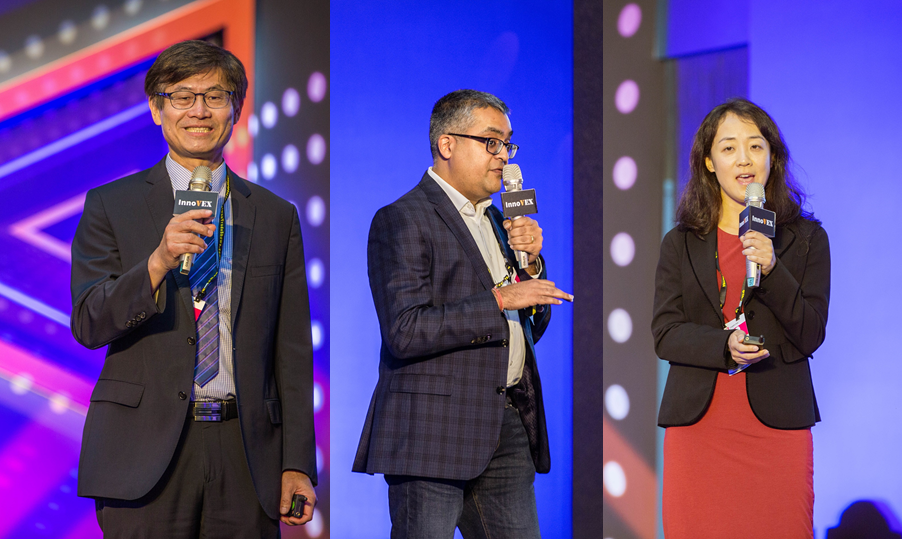
The Qualcomm forum session focused on Entrepreneurial Opportunities on IoT was separated into 3 keynote speeches and a panel discussion. Discussing the opportunities for Taiwan in the first keynote was Dr. Yu-Chin Hsu, the Deputy Minister of Ministry of Science and Technology (MOST). The second keynote was by Mr. Sahil Bansal, Senior Director of Product Management of Qualcomm Incorporated who discussed the Emerging Growth & Opportunities for AI &IoT. The third keynote in the session was by Ms. Yan Li, Director of Qualcomm Ventures who discussed Investing in the Future of Mobile.
Taiwan in the Age of IoT and Startups
In his keynote; Dr. Yu-Chin Hsu pointed out the 3 tech clusters of Taiwan: North, Central, and South region which started from Science Parks in Hsinchu, Taichung, and Tainan respectively. These tech clusters excel in different industries and different aspects of the industries such as IC design & manufacturing in the North, precision machinery in the Central, and IC foundry in the South.
Taiwan’s strengths in IC have begun back in the 1960s when IC was invented, then introduced to the Science Parks. According to Dr. Hsu, IC or semiconductor design is so deeply ingrained in Taiwan that it is metaphorically possible for consumers to find a company in those industries within a 1 hour drive from any point in Taiwan.
The 10 year strategy of the Ministry is to shift from existing strengths to the future industries such as AI, IoT, Big Data, and Software. The focus has also shifted to allow more startups and software companies to join the science parks. In fact, the development of the tech clusters for these industries have started.
MOST previously focused only on basic research and strategic programs; however they need to improve their ability to connect technology to the market and capital. To further help startups, MOST formed Taiwan Tech Arena (TTA) to support startups in 4 aspects: talent, technology, market, and capital. Supporting talent is the foundation to a successful startup ecosystem as the talents are the ones who create technologies; the created technologies can then be commercialized and enter the market. However, for this sequence to happen, the talents will need funding.
Emerging Growth & Opportunities for AI in IoT
Mr. Bansal of Qualcomm started his keynote by pointing out the ubiquity of IoT in today’s life, with growing trend of driving a variety of use cases. It is one of the cornerstones of smart home where many devices are interconnected in the home and can interoperate with one another; including in some cases where AI is incorporated into the device itself.
Qualcomm believes mobile technologies can drive innovation in IoT; pushing for large investments in the mobile technologies. In terms of IoT, there are 3 vectors which are needed to make a successful use case: connectivity, security, and computing. The IoT device will need to be able to connect to different devices through multiple communication networks & infrastructure; comes equipped with software & hardware based security mechanism; and a variety of different computing engines that can be used for multiple purposes.
According to Mr. Bansal; devices, machines, and thing in general are becoming more intelligent. However, the intelligence or computing process is steadily moving away from servers or cloud to the devices themselves. This trend is not only an improvement, it is the next natural step to make sure the system will be able to process the data as close to the edge as possible for privacy reasons, latency minimization, increasing reliability, as well as better and more efficient use of bandwidth. Of course, this means that the IoT systems will still need high bandwidth and low latency connection to function; especially as customers ask for a higher performance and compute at the edge.
The proposed solution is to integrate AI in the IoT device as AI is slowly becoming more and more omnipresent in electronic devices. The challenges with AI on device are that AI poses a very compute intensive workload and it runs the system in a constrained device environment; essentially creating power and thermal efficiency issues.
Qualcomm believes that it is important to provide more than just the base offer of System on a Chip (SoC); but also the full reference platform to enable the different verticals of IoT. Users will definitely prefer customizable reference platforms for different functions.
Investing in the Future of Mobile
Ms. Yan Li stated that as the VC arm of Qualcomm Incorporated, Qualcomm Ventures focuses their investing portfolio on 5G, AI, IoT, Mobile, Automotive, and Networking; all of which are business directly related to Qualcomm. Their choice to invest in mobile ecosystem is because they believe that intelligently connecting mobile systems will be the future. The unique values presented as part of Qualcomm are that they are able to connect entrepreneurs with rich resources & powerful networks to accelerate their success. In addition, the strong connection in the mobile ecosystem can bridge connections within Qualcomm and with external partners.
Their most current investment strategy is to invest in scalable platforms and technologies. They divided the areas of focus into 3: interaction & perception technologies, edge computing & network operations, and vertical platforms & enabled platforms.
Ms. Li believes 5G will bring a new era and will help connect devices intelligently. Currently, there are 4 areas directly related to 5G: AI, XR, robotics, and IoT. There are already quite a few startups in these industries and their products and services mostly cover a combination of these areas. 5G will be able to bring a massive scale in IoT; connecting over a million devices in a square kilometer area. In addition, due to their long range, efficient power, and extreme simplicity, it makes sense to combine 5G with the mobile technologies.
To watch the full forum session, visit our YouTube channel here.